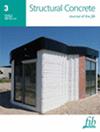多因素影响下的超高性能混凝土湿接缝界面内聚力模型
IF 3.3
3区 工程技术
Q2 CONSTRUCTION & BUILDING TECHNOLOGY
引用次数: 0
摘要
预制普通混凝土(NC)和现浇超高性能混凝土(UHPC)之间的界面内聚力是评估其界面粘结强度的一个重要指标,这对于将 UHPC 用作预制结构桥梁的连接材料具有重要意义。界面内聚力与多个影响因素有关。然而,对于多种影响因素与界面内聚力之间的相互关系模型还需要更多的研究。本研究以预制混凝土结构中的 UHPC 湿接缝为对象。首先,研究了 UHPC 湿接缝界面内聚力与基底强度、UHPC 龄期、界面粗糙度、界面含水率和养护方法之间的关系;结果表明,影响界面内聚力的关键因素包括 UHPC 龄期、界面粗糙度和基底强度,界面含水率可能起次要作用。其次,利用数字图像相关性(DIC)将界面区表面的破坏类型分为三类。最后,根据上述四个因素建立了多因素耦合作用下界面内聚力的定量数学模型。该模型与实验数据吻合良好。本文章由计算机程序翻译,如有差异,请以英文原文为准。
Interfacial cohesion model of ultra‐high performance concrete wet joints under the influence of multiple factors
The interfacial cohesion between precast normal concrete (NC) and cast‐in‐place ultra‐high performance concrete (UHPC) is an important index to evaluate their interfacial bond strength, which is of great importance for the application of UHPC as a connection material for precast structural bridges. Interfacial cohesion is related to several influencing factors. However, there needs to be more research on the interrelationship model between multiple influencing factors and interfacial cohesion. This study took the UHPC wet joint in a precast concrete structure as the object. First, the relationship between the interface cohesion of UHPC wet joint and substrate strength, UHPC age, interfacial roughness, interfacial moisture content, and curing method was studied; The result shows that the key factors affecting interfacial cohesion include UHPC age, interface roughness, and substrate strength, with interfacial moisture content potentially playing a secondary role. Second, the failure types of the interface zone surface by using digital image correlation (DIC) are divided into three categories. Finally, the quantitative mathematical model of interfacial cohesion under the coupling effect of multiple factors was established based on the above four factors. The model is in good agreement with the experimental data.
求助全文
通过发布文献求助,成功后即可免费获取论文全文。
去求助
来源期刊

Structural Concrete
CONSTRUCTION & BUILDING TECHNOLOGY-ENGINEERING, CIVIL
CiteScore
5.60
自引率
15.60%
发文量
284
审稿时长
3 months
期刊介绍:
Structural Concrete, the official journal of the fib, provides conceptual and procedural guidance in the field of concrete construction, and features peer-reviewed papers, keynote research and industry news covering all aspects of the design, construction, performance in service and demolition of concrete structures.
Main topics:
design, construction, performance in service, conservation (assessment, maintenance, strengthening) and demolition of concrete structures
research about the behaviour of concrete structures
development of design methods
fib Model Code
sustainability of concrete structures.
 求助内容:
求助内容: 应助结果提醒方式:
应助结果提醒方式:


